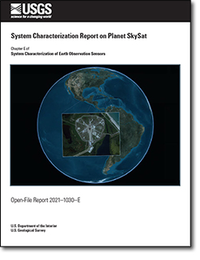System Characterization Report on Planet SkySat
Links
- Document: Report (1.73 MB pdf)
- Larger Work: This publication is Chapter E of System characterization of Earth observation sensors
- Download citation as: RIS | Dublin Core
Abstract
This report addresses system characterization of Planet’s SkySat and is part of a series of system characterization reports produced and delivered by the U.S. Geological Survey Earth Resources Observation and Science Cal/Val Center of Excellence. These reports present and detail the methodology and procedures for characterization; present technical and operational information about the specific sensing system being evaluated; and provide a summary of test measurements, data retention practices, data analysis results, and conclusions.
SkySat is a constellation of submeter resolution Earth observation satellites providing analytics services, high-definition video, and imagery. The goal for the constellation is to capture multiple daily repeats of high-resolution imagery over any spot on the Earth. As of September 2020, 21 SkySat satellites have been launched, and the first launch occurred in November 2013. More information on Planet satellites and sensors is available in the “2020 Joint Agency Commercial Imagery Evaluation—Remote Sensing Satellite Compendium” and from the manufacturer at https://www.planet.com/.
The Earth Resources Observation and Science Cal/Val Center of Excellence system characterization team completed data analyses to characterize the geometric (interior and exterior), radiometric, and spatial performances. Results of these analyses indicate that SkySat has an interior geometric performance in the range of a 0.38- (0.47 pixel) to 0.75-meter (m; 0.93 pixel) root mean square error in easting and a 0.27- (0.33 pixel) to 0.55-m (0.68 pixel) root mean square error in northing, in band-to-band registration; an exterior geometric performance in the range of 0.26 (0.32 pixel) to 1.04 m (1.28 pixels) offset in comparison to ground control points; a radiometric performance in the range of 0.033 to 0.797 (linear regression); and a spatial performance in the range of 3.7 to 4.3 pixels at full width at half maximum, with a modulation transfer function at a Nyquist frequency in the range of 0.004 to 0.009.
Suggested Citation
Kim, M., Park, S., Sampath, A., Anderson, C., and Stensaas, G.L., 2022, System characterization report on Planet SkySat, chap. E of Ramaseri Chandra, S.N., comp., System characterization of Earth observation sensors: U.S. Geological Survey Open-File Report 2021–1030, 17 p., https://doi.org/10.3133/ofr20211030E.
ISSN: 2331-1258 (online)
Table of Contents
- Executive Summary
- Introduction
- System Description
- Standardized Procedures
- Measurements and Results Summary
- Analysis
- Summary and Conclusions
- Selected References
| Publication type | Report |
|---|---|
| Publication Subtype | USGS Numbered Series |
| Title | System characterization report on Planet SkySat |
| Series title | Open-File Report |
| Series number | 2021-1030 |
| Chapter | E |
| DOI | 10.3133/ofr20211030E |
| Publication Date | January 07, 2022 |
| Year Published | 2022 |
| Language | English |
| Publisher | U.S. Geological Survey |
| Publisher location | Reston, VA |
| Contributing office(s) | Earth Resources Observation and Science (EROS) Center |
| Description | iv, 17 p. |
| Larger Work Type | Report |
| Larger Work Subtype | Other Government Series |
| Larger Work Title | System characterization of Earth observation sensors |
| Online Only (Y/N) | Y |
| Additional Online Files (Y/N) | N |


